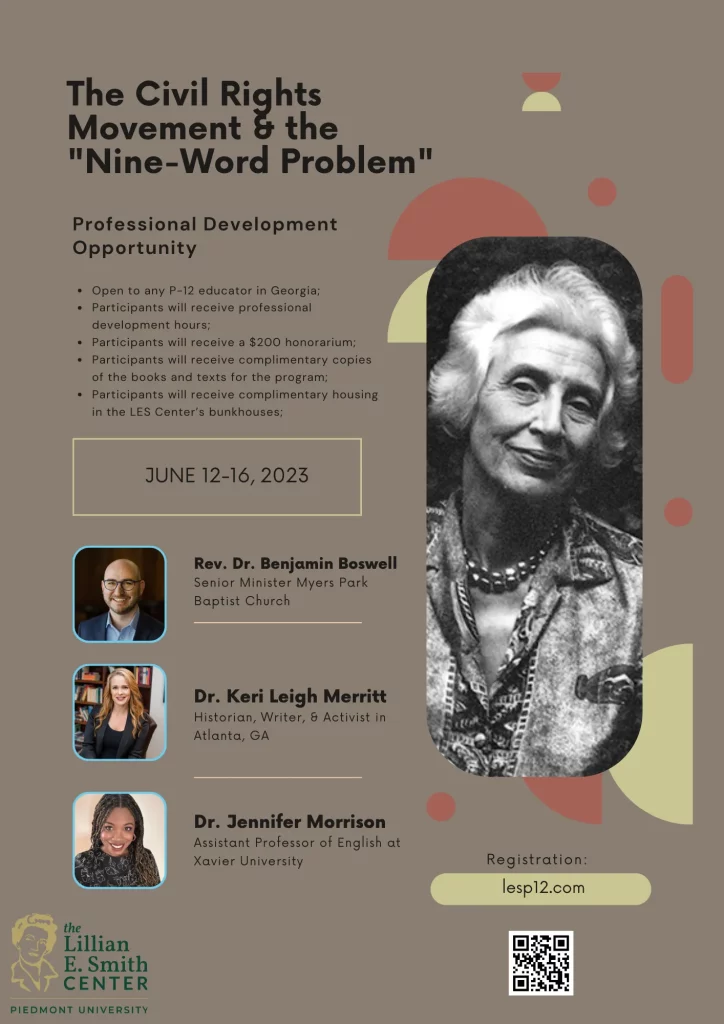“The Civil Rights Movement and the Nine-Word Problem” Professional Development Opportunity
Written by Director of the Lillian E. Smith Center, Dr. Matthew Teutsch
As she prepared to close Laurel Fall Camp for Girls, a camp she ran from 1925–1948, Lillian Smith wrote, “I hope that the idea of Laurel Falls will not die. I want to believe that we have started a chain reaction of dreams that will go on touching child after child in our South.” The Lillian E. Smith Center’s programs, specifically its annual P-12 professional development program for regional educators, continues Smith’s goal of starting that chain reaction that will impact children and communities not just in the South by nationally and globally. Last year, we hosted our first institute, “The Civil Rights Movement in Northeast Georgia,” and this year, we are preparing to host our second annual institute, “The Civil Rights Movement and the Nine-Word Problem.”
During the week-long institute, participants will have sessions with Dr. Rev. Benjamin Boswell, Dr. Keri Leigh Merritt, and Dr. Jennifer Morrison, among environmental science activities with faculty from Piedmont University. They will explore the Civil Rights Movement beyond what the Southern Poverty Law Center calls “the nine-word problem” of confining the movement to “Rosa Parks, Martin Luther King, I Have a Dream.” Participants will do this by looking at works by Lillian Smith, Pauli Murray, Ernest Gaines, and Martin Luther King, Jr. While the institute cannot provide an all-encompassing view of the movement, stretching beyond the bounds of 1954–1968, it will provide participants with materials to bring back to their classrooms that adhere to state educational standards.
When I conceptualize programs such as this, I always think about the facilitators and how their work connects with the overall themes and goals of the institute. Each institute uses Lillian Smith as the fulcrum to assist educators in addressing various Georgia educational standards for history such as the United States History standard 21:d which reads, “Investigate the growth, influence, and tactics of civil rights groups, Martin Luther King, Jr., the Letter from Birmingham Jail, the I Have a Dream Speech, and Cesar Chavez.” As well, it will address the Civic Government standard 7: “Demonstrate knowledge of civil liberties and civil rights.” In ELA, the institute addresses standards such as ELAGSE11–12R19 which asks students to “Analyze foundational U.S. documents of historical and literary significance.” These are not the only standards that the institute will address, but they are some of the main standards.
To meet these goals, I consider facilitators who have educational experience, at any level, and who can provide P-12 educators with information and material to assist them in meeting these educational standards and others. This year, Boswell, Merritt, and Morrison will serve as facilitators, exploring with participants the works of Civil Rights activists Pauli Murray, Lillian Smith, and Martin Luther King, Jr. along with the fiction of Ernest Gaines which explores the impact of the Civil Rights Movement on his little postage stamp of land in South Louisiana. Each of these activists and writers took part in the Civil Rights Movement. Some marched across the Edmund Pettus Bridge in Alabama on Bloody Sunday or were jailed for demonstrating. Some led March on Washington events in 1942 to protest the state execution of Odell Waller. Some wrote extensively on the impact of racism not just on those who experience but on those who commit its atrocities. Some wrote about how the movement took time to reach into certain areas, and the impact that delay had on the communities.
Over the course of the institute, participants will have the opportunity, as well, to work on their own lesson plans and projects that they can bring back to their own classrooms. They will have the chance to work with the facilitators and one another in the construction of materials that will benefit their students. Along with this, they will also learn about Mary Hambidge, a weaver who lived and worked near Lillian Smith in Rabun County, and they will also learn about the flora and fauna of the region, opening up the opportunity for the sciences to take advantage of the natural habitat of the Lillian E. Smith Center and the surrounding region.
Finally, the facilitators bring an expanse of knowledge about their areas of interest back to Lillian Smith’s impact on their own work. Over the years, I have spoken with each of them for the Lillian E. Smith Center’s podcast “Dope with Lime” and learned about the ways that Smith has impacted them both personally and professionally, each in different ways. Their connection with Smith, and their discoveries of Smith’s work, remind me of the importance of institutes such as this. They serve as spaces for educators to learn, in more detail, about individuals and movements and to bring that knowledge and understanding back to their own classrooms.
Information about the institute and how to apply can be found below:
Program Details:
- Deadline for applications, May 1, 2023;
- Open to any P-12 educator in Georgia;
- Takes place June 12–16, 2023;
- Participants will receive professional development hours;
- Participants will receive a $200 honorarium;
- Participants will receive complimentary copies of the books and texts for the program;
- Participants will receive complimentary housing in the LES Center’s bunkhouses;
Readings:
- The Lillian E. Smith Reader, eds. Rose Gladney and Lisa Hodgens
- Gaines, Ernest. Bloodline.
- Selections from Pauli Murray
- Selections from Martin Luther King, Jr.
Applications will consist of a CV and a brief statement of purpose (500–1,000 words) describing why you are interested in the program. Please email these to lescenter@piedmont.edu.
Participants will be notified of acceptance by May 15, 2023.
If you would like more information, visit https://lesp12.com or contact us at lescenter@piedmont.edu.
